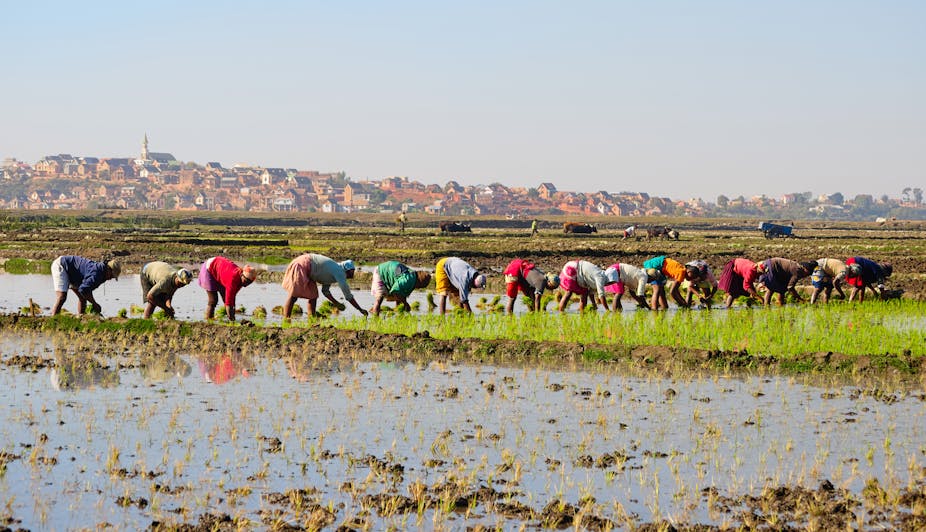Swamps, marshes, floodplains and mangrove forests, all known as wetlands, are a precious resource. In their natural state they provide a range of eco-system services. They regulate water flows, store eroded materials and nutrients and provide water, food and raw materials. Wetlands are defined as areas that are subject to seasonal or permanent flooding up to a depth of 6m.
Throughout history, the general trend has been to convert wetlands from their natural state to allow other more intensive uses. In some parts of the world this has involved the creation of rice paddies, sugar estates or even fish farms. In Europe, North America, Australia and New Zealand more than 50% of wetlands were converted to other uses during the 20th century by controlled flooding and drainage. Mostly they were used for intensive farming and urban development.
In recent decades, particularly in Africa, wetlands have become a new agricultural frontier. In response, a number of agencies are trying to explore sustainable wetland management as a way of reducing rural poverty, improving food security and strengthening livelihood resilience in the face of climate change.
Wetlands as a buffer against disaster
World Wetland Day is marked ever year as part of an effort to highlight their importance and value. This year, the focus is on the vital role of healthy wetlands in reducing the impact of extreme events such as floods, droughts and cyclones on communities and in helping to build resilience.
The best known example of wetlands for disaster risk reduction is probably the mangrove swamps in the tropics. On the east and west coasts of Africa these areas provide a buffer against storm surges, cyclones and tsunamis, as well as providing breeding grounds for fish and storage of carbon.
In Europe, flood control and water management agencies are now re-discovering the natural role of floodplains in reducing flood levels. In the Netherlands, for example, the government is negotiating with farmers to allow farmland to be floodedto reduce the height of floods and the threats to settlements.
There are also several examples in sub-Saharan Africa of wetland use which can help reduce disasters and improve resilience. For example, the small-scale cultivation of inland wetlands, such as the bas fonds in West Africa or dambos in southern Africa. These play an important role in helping communities survive during the long dry season and avoid seasonal hunger. In this way disaster risks are reduced.
Wetlands are also feeding towns and generating income, as well as savings, for farmers. They can use this extra cash to develop their farms and diversify their enterprises. In Mpika, northern Zambia, some successful wetland farmers have developed retail and house rental enterprises, whilst others have used their newly accumulated capital for trading in grain.
Managing wetlands better
In Africa, a range of organisations, from community groups to international agencies have recognised the way in which wetlands can be important for poverty reduction, livelihood security and resilience in the face of climate change. A number of initiatives are underway to explore how wetlands can be managed sustainably.
One example is the Striking a Balance project in Zambia and Malawi. In many parts of both countries farmers are heavily dependent on wetlands. Research shows that in three sites in Simlemba, central Malawi, 88% of farmers use wetlands for more than water collection. Their other activities, primarily cultivation but also reed collection, derived from wetlands account for 37% of their domestically consumed food and generate 55% of their cash income.
But with growing rural populations, the degradation of upland fields due to prolonged farming, and climate change wetlands are under increasing pressure as farmers seek out fertile and moist sites. However, the increased flows of water from degraded uplands into the wetlands and the disturbance of natural vegetation by cultivation in the wetlands threatens erosion and damage to these valuable sites.
During the project, farmers analysed the risks they faced in relying so heavily on wetlands and identified measures they could take to make wetland use more sustainable and productive. These included:
adjusting cultivation sites to the water table at different times of the year, using raised bed as the flood declines and depression beds in the driest times when the water table is lowest
using compost to improve soil structure and mulching with plant residues between plants to reduce water loss in the hottest time of the dry season, and
not cultivating in the middle of wetlands which can encourage gulley formation during the flood season.
Farmers also realised that the wetlands depended on well-managed catchment areas. Measures were identified to improve upland management. These included improving land use through using soil and water conservation measures, inter-planting crops with agro-forestry trees, and maintaining areas of natural vegetation all of which facilitate water infiltration. This water percolates through to the wetlands several months later.
This landscape approach pioneered by Striking a Balance is being explored in other locations across Africa to build resilience in the face of climate change.
For example, in West Africa, the inter-governmental Africa Rice Center is working to develop community planned and managed wetland use. It’s estimated that transforming just 10% of wetlands can provide food security for the region through rice cultivation. The rest of the wetlands can be left in a natural state to stabilise flows and reduce flooding and erosion in the cultivated areas.
Managing wetlands more effectively and efficiently in Africa is inextricably linked to improving people’s livelihoods and their resilience in the face of disasters. The way to progress this is to empower communities to manage wetlands themselves, using their local knowledge and building institutions to develop and apply practices for productive use.

